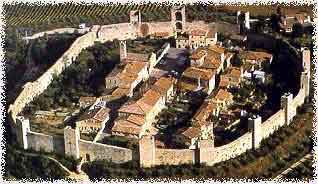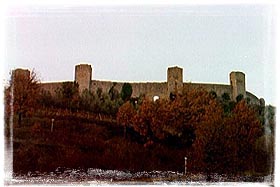Walled town of Monteriggioni
 |
| Aerial view of the intact walls of Monteriggioni. In foreground the front toward Florence. |
Monteriggioni is in province of Siena, around half road between the chief town and Colle Valdelsa. It's easily reachable with the speedway Florence-Siena from the homonym exit.
Click for a Map - More Photos
Monteriggioni is without doubt one of the most classical and best known Italian walled town. Since the Middle Age its fame was so great that also the great poet Dante makes sign to his 'round enclosure' in the Divine Comedy (Hell, chant XXXI vv. 40-41). The walls, nearly intact, cover a length of 570 meters and are alternated by 14 towers and two gates. The Senese gate rises at the base of a tower while that toward Florence is opened in the curtain and defended from one of the towers of the fortified perimeter.
The town was built by the Senesis in the years 1213-1219 on a hillock at dominion and overlooking of the Cassia Road. Its ideal position allowed to control the Elsa and the Staggia Valleys in direction in Florence, the historic enemy of Siena, that at that time was rapidly expanding its territory.
 |
| The front toward Florence. |
The hill where Monteriggioni rises is natural, even if it could seem a great 'motte' (from the name of the classical Norman castles 'Motte-and-Bailey' built on artificial hills and gifted of enclosure), and the circular, almost perfectly, layout of the walls was obtained simply following the sketch of the ground's curves of level. In the planning was tried of to limit the weak points for excellence, the gates, entrusting the only connections with the outside only to a east to west crossing road. To Monteriggioni the military building work appears physically distinguished by the inhabited area confined to its inside but well separated from the walls from a 'territory of respect', although in the ancient times the inhabited area has been more intense than today and consequently with a more narrow band of separation. The suburb that we can admire our days is essentially authentic, being ever been object of building and tourist speculations. The only changes to its aspect happened in the first years of the 16th century when, trying to conform the fortifications to the development of the new fire weapons, were lowered the towers and accumulated earth at the base of the walls with the purpose to get a bastionated effect.
| More Photos |
| View a Map |
| Back to Homepage |
| Back to Castles Index |

